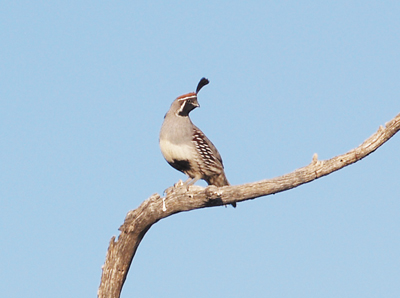
Eco-friendly Cave Creek is for the birds
By Sara Fassil | November 25, 2009
 CAVE CREEK – Cave Creek is the official home to a new ecosystem aimed to protect the hundreds of bird species living and migrating to the town.
CAVE CREEK – Cave Creek is the official home to a new ecosystem aimed to protect the hundreds of bird species living and migrating to the town.
This new ecosystem has been dubbed an Important Bird Area (IBA), said Bambi Muller, Associate Planner and Trails Coordinator for the town. Cave Creek is the first municipality to adopt an IBA in the state of Arizona.*
The IBA runs along 4000 acres of flood plain, starting at Carefree Highway and continues through Jewel of the Creek, Cottonwood Wash, Walnut Creek and up to Seven Springs in the Tonto National Forest, said Tice Supplee, Audubon Arizona Director of Bird Conservation.
Audubon Arizona, an organization whose mission is to protect birds and other wildlife, wants citizens of Cave Creek to “recognize the IBA for its conservation values and contribution to the ecological diversity to the community,” said Supplee.
Audubon Arizona recognizes the IBA as an area where many birds have been living and using as a migratory flyway. They proposed that the Open Space Citizen Advisory Group (OSCAG), a group formed by the Mayor and Town Council of Cave Creek to conserve and protect the Sonoran Desert, integrate the IBA into plans and recreational opportunities for the town.
Muller said that much of the land that is part of the IBA is private property and cannot be touched by Audubon Arizona or OSCAG. However, these organizations want to identify the IBA as an area of value to the Sonoran Desert. They hope those who own the private property will not disturb the habitat.
Cave Creek residents and residents from other Arizona cities, have been donating money to help fund the IBA, said Muller. So far, the OSCAG has raised $40,000 and is in the process of writing a grant for more funding.
Mike Rigney, assistant utilities manager and water advisory committee coordinator, said approximately 200 different bird species inhabit the IBA throughout the year. Rigney, who also has a background in ornithology, said some of the bird species at IBA include warblers, ravens, herons, 14 different species of humming birds, hawks, flycatchers, wrens, sparrows, falcons, owls, roadrunners, woodpeckers and quail. Arizona has the fourth highest diversity of bird species in the United States. It would be number one if it had a coast, Rigney said.
In the winter, many birds migrate to the IBA from the tropics. The migratory and native birds depend on the big trees and bushes that are in the flood plain, said Rigney. This habitat is rare in Arizona and attracts many species of birds.
Rigney said there are several areas of the IBA that are not on private property and can be used recreationally. While motorized activities are not permitted in this area, visitors can walk along trails, hike, mountain bike, ride horses and bird watch.
“We want people to recognize the fact that we appreciate birds and what they bring to the community,” said Rigney.
View the IBA map
